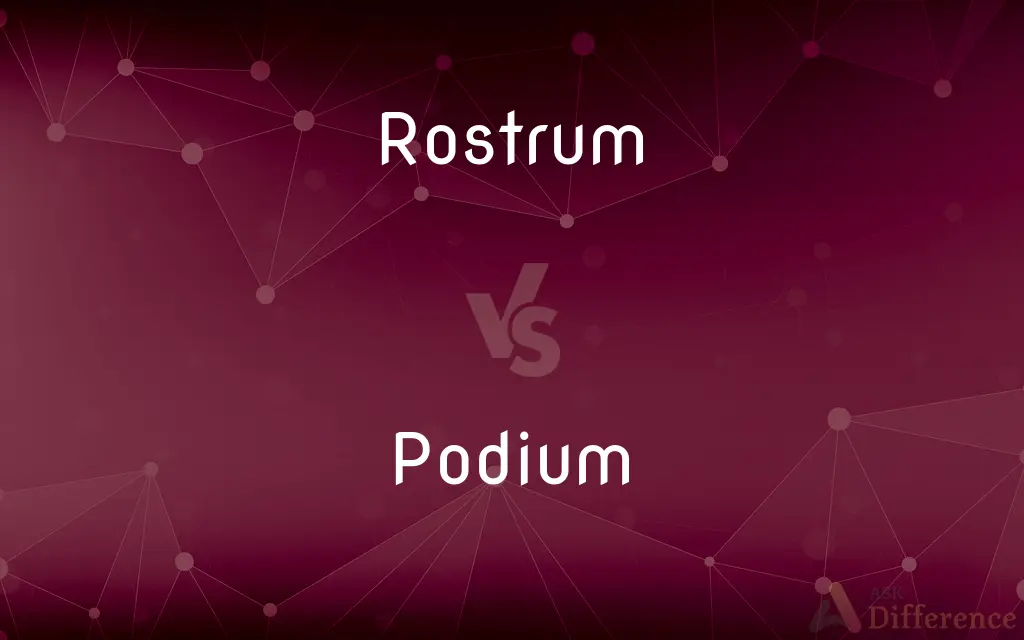Rostrum vs. Podium — What's the Difference?
By Maham Liaqat & Urooj Arif — Updated on April 22, 2024
Rostrum refers to a platform for speakers or performers, emphasizing its elevation, while a podium is a low platform for a conductor or speaker, often used in award ceremonies.

Difference Between Rostrum and Podium
Table of Contents
ADVERTISEMENT
Key Differences
A rostrum is traditionally a raised platform used for public speaking or performances, providing visibility and prominence to the speaker. Whereas a podium, derived from the Greek word for "foot", is typically lower and used in contexts like orchestral conducting or sports where speakers or winners are highlighted.
Rostrums are often found in formal settings such as lecture halls and legislative assemblies, designed to elevate the speaker above the audience, thereby commanding attention and respect. On the other hand, podiums are common in sports and academic award ceremonies, focusing on elevating individuals slightly above the ground level to signify achievement or leadership.
The design of a rostrum is usually more elaborate, often featuring ornate decorations and a significant height that distinguishes it from its surroundings. In contrast, podiums are generally simpler, often just a step or two above ground level, with a design that serves functionality over form.
Rostrums serve a symbolic role in addition to their practical function, often representing power and authority. Podiums, while they also convey a sense of importance, are more closely associated with achievement and recognition, marking a spot of honor rather than authority.
In terms of usage, speakers on a rostrum are typically addressing larger audiences, and the structure may include features like microphones and sound amplification. Podiums, although they can also be equipped with similar features, are more likely to be used in smaller, more intimate gatherings or in situations where the highlight is on individual recognition rather than mass communication.
ADVERTISEMENT
Comparison Chart
Height
Typically higher, elevating the speaker
Lower, often just a step above ground
Usage Context
Formal speeches, performances
Award ceremonies, orchestral conducting
Symbolism
Represents authority and power
Signifies achievement and honor
Design
Often ornate and elaborate
Simpler and functional
Audience Size
Larger, for mass communication
Smaller, more intimate or ceremonial
Compare with Definitions
Rostrum
A stage for formal speeches.
Graduates gathered around the rostrum, waiting for their names to be called.
Podium
A dais for presentations.
The scientist presented her findings from the podium.
Rostrum
A platform for a speaker or performer.
The conductor stood on the rostrum, commanding the orchestra with ease.
Podium
A base for public speakers.
The lecturer stood at the podium, delivering the keynote speech.
Rostrum
A platform in legislative assemblies.
The senator approached the rostrum to debate the new policy.
Podium
A platform for conductors.
The conductor directed the performance from the podium at the front of the stage.
Rostrum
A ceremonial platform.
The award ceremony was held on the grand rostrum in the city hall.
Podium
A stand used in competitions.
Winners stood proudly on the podium, holding their trophies high.
Rostrum
A raised platform for public speaking.
The politician stepped onto the rostrum to address the eager crowd.
Podium
A low platform used in award ceremonies.
The athletes climbed the podium to receive their medals.
Rostrum
A dais, pulpit, or other elevated platform for public speaking.
Podium
A podium (plural podiums or podia) is a platform used to raise something to a short distance above its surroundings. It derives from the Greek πόδι (foot).
Rostrum
The curved, beaklike prow of an ancient Roman ship, especially a war galley.
Podium
An elevated platform, as for an orchestra conductor or public speaker.
Rostrum
The speaker's platform in an ancient Roman forum, which was decorated with the prows of captured enemy ships.
Podium
A stand for holding the notes of a public speaker; a lectern.
Rostrum
An anterior projection of an insect's or an arachnid's mouthparts, of the upper jaw of a cetacean, or of the cephalothorax of a crustacean.
Podium
A low wall serving as a foundation.
Rostrum
A beaklike projection of a plant part, as the fruit of a geranium.
Podium
A wall circling the arena of an ancient amphitheater.
Rostrum
A dais, pulpit, or similar platform for a speaker, conductor, or other performer.
Podium
(Biology) A structure resembling or functioning as a foot.
Rostrum
A platform for a film or television camera.
Podium
To complete a competition, especially a race, as one of the top three contestants, usually being honored while standing on a podium.
Rostrum
The projecting prow of a rowed warship, such as a trireme.
Podium
A platform on which to stand, as when conducting an orchestra or preaching at a pulpit; any low platform or dais.
Rostrum
(zoology) The beak.
Podium
(sometimes proscribed) A stand used to hold notes when speaking publicly.
Rostrum
(zoology) The beak-shaped projection on the head of insects such as weevils.
Podium
A steepled platform upon which the three competitors with the best results may stand when being handed their medals or prize.
Rostrum
(zoology) The snout of a dolphin.
Podium
(sports) A result amongst the best three at a competition.
Rostrum
(anatomy) The oral or nasal region of a human used for anatomical location (i.e. rostral)
Podium
A low wall, serving as a foundation, a substructure, or a terrace wall.
Rostrum
The beak or head of a ship.
Podium
The dwarf wall surrounding the arena of an amphitheatre, from the top of which the seats began.
Rostrum
The Beaks; the stage or platform in the forum where orations, pleadings, funeral harangues, etc., were delivered; - so called because after the Latin war, it was adorned with the beaks of captured vessels; later, applied also to other platforms erected in Rome for the use of public orators.
Podium
The masonry under the stylobate of a temple, sometimes a mere foundation, sometimes containing chambers.
Rostrum
Hence, a stage for public speaking; the pulpit or platform occupied by an orator or public speaker.
Myself will mount the rostrum in his favor.
Podium
A foot or footstalk.
Rostrum
Any beaklike prolongation, esp. of the head of an animal, as the beak of birds.
Podium
To finish in the top three at an event or competition.
The swimmer podiumed three times at the Olympics.
Rostrum
Same as Rostellum.
Podium
A low wall, serving as a foundation, a substructure, or a terrace wall.
Rostrum
The pipe to convey the distilling liquor into its receiver in the common alembic.
Podium
The foot.
Rostrum
A pair of forceps of various kinds, having a beaklike form.
Podium
A platform raised above the surrounding level to give prominence to the person on it
Rostrum
A platform raised above the surrounding level to give prominence to the person on it
Rostrum
Beaklike projection of the anterior part of the head of certain insects such as e.g. weevils
Common Curiosities
Can a podium have multiple levels?
Yes, podiums, especially in sports, often have multiple levels to distinguish between first, second, and third places.
What is the primary function of a rostrum?
A rostrum is primarily used to elevate a speaker above an audience, enhancing visibility and audibility.
What types of events typically use a podium?
Podiums are often used in award ceremonies, musical performances, and sports events.
Where might you find a rostrum being used?
Rostrums are commonly used in formal settings like universities, parliaments, or large public gatherings.
Is a rostrum suitable for small group presentations?
Rostrums are typically designed for larger audiences and may be too formal for small group interactions.
Does the height of a podium affect its function?
Yes, the height of a podium is designed to slightly elevate the speaker for visibility without separating them too much from the audience.
How does the audience perceive a speaker on a rostrum versus a podium?
Speakers on rostrums are perceived with a sense of authority and formality, while those on podiums are seen in a context of celebration and achievement.
How is a podium different from a rostrum in terms of design?
Podiums are generally simpler and lower than rostrums, which are often ornate and significantly elevated.
Can both a rostrum and a podium be used in the same event?
Yes, it's possible, especially in large conferences or competitions where different aspects of the event require varied forms of speaker engagement.
What is the symbolic significance of a rostrum?
A rostrum symbolizes authority and control, often used in settings where governance or leadership is emphasized.
What does standing on a podium symbolize?
Standing on a podium generally symbolizes achievement, honor, and recognition in a specific field or activity.
Can podiums be adjusted for height?
Some podiums are adjustable to accommodate different speaker heights, enhancing versatility.
What materials are typically used to build a rostrum?
Rostrums are often made from wood, metal, or composites, depending on the formality and permanence of the setting.
Are rostrums portable?
While some rostrums are built-in, portable versions exist for various event needs.
Are there any specific etiquette rules for using a rostrum or podium?
Yes, proper etiquette involves acknowledging the audience and using the space respectfully to maintain the dignity associated with these platforms.
Share Your Discovery

Previous Comparison
Avobenzone vs. Benzene
Next Comparison
Ship vs. BargeAuthor Spotlight
Written by
Maham LiaqatCo-written by
Urooj ArifUrooj is a skilled content writer at Ask Difference, known for her exceptional ability to simplify complex topics into engaging and informative content. With a passion for research and a flair for clear, concise writing, she consistently delivers articles that resonate with our diverse audience.
















































